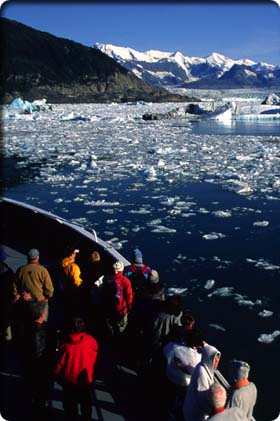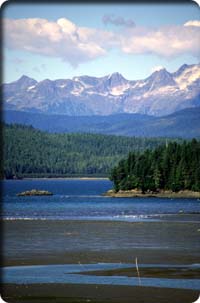| a l a s k a j o u r n e y . c o m |
| Southcentral Mountains & Prince William Sound |
|
Chugach National Forest Location/Size: Eastern Kenai Peninsula and Prince William Sound. 5.6 million acres. Main Activities: Wilderness exploration, hiking, fishing, sea kayaking, river running, mountaineering, backcountry stays, wildlife observation, glacier viewing. Gateway Towns/Getting There: Portage, Whittier/scheduled ferry service to Whittier from Valdez and Homer, vehicle access to Portage via Seward Highway, Alaska Railroad shuttle or new road link from Portage to Whittier; Valdez/vehicle access via Richardson Highway, scheduled ferry from Whittier and Seward, scheduled air from Anchorage and other points; Cordova/scheduled ferry from Valdez, scheduled air from Anchorage; Seward/vehicle access via Seward Highway, scheduled ferry from Valdez and Homer, scheduled air service from Anchorage. Park access: road and trail access in eastern Kenai Peninsula, sea-kayak and tour-boat access in Prince William Sound, road and trail access from Cordova, river access in Copper River valley and delta, floatplane and glacier landings elsewhere. Facilities, Camping, Lodging: Beggich Boggs Visitor Center at Portage Glacier, Turnagain Pass Winter Sports Area south of Portage on the Seward Highway (ski area). Several campgrounds are located along the Seward and Sterling Highways on the Kenai Peninsula; one is found east of Cordova on Alaganik Slough. All other camping is primitive. There are 41 Forest Service cabins and all are reservable; the Kenai Peninsula has 19, Prince William Sound has 15, and the Cordova area has 7. Cabins are $25 to $40 per night. Reservations can be made in person only at the ranger district offices, and in person or by mail at the Alaska Public Lands Information Center (see below). Headquarters and Information: Glacier Ranger District, 783-3242; Cordova Ranger District, 424-7661; Seward Ranger District, 224-3374; Alaska Public Lands Information Center, 605 West 4th Avenue, Suite 105, Anchorage, 271-2599; Chugach National Forest Supervisor, Anchorage, 271-2500.
This mountain-wrapped, island-rich bay on the northern edge of the Gulf of Alaska is famous as a beautiful travel destination, as an area rich in fish and wildlife, and as the victim of a drunken tanker captain. Long one of Alaska’s three premier coastal tour regions, Prince William Sound was thrust into national awareness in 1989 when the Exxon Valdez leaked 258,000 barrels of oil—about 20 percent of its cargo—into the water. The oil spill was not the first cataclysm to strike the region. In 1964, Valdez and Cordova were both severely damaged by a great earthquake and the ensuing tsunamis. Cordova had to move and rebuild its harbor, while the entire town of Valdez was relocated to new ground. While the region has seen it all, it remains one of the most beautiful areas of the state, well salted with some amazing and very human stories of trial and triumph. The A.M.H.S. ferries are a good way to experience the sound. If you’re traveling by car, consider driving to Valdez, then continuing by ferry to Whittier, where you can take the short rail shuttle or new road link to Portage and the Seward Highway (Portage to Valdez works just as well). Kowtowing to the greed of the cruise lines, the state no longer allows the ferry to enter Columbia Bay for a decent look at Columbia Glacier. Other ferry routes incorporate Cordova, which has regular air connections to Anchorage and elsewhere. Taking a vehicle to Cordova is an expensive luxury since the road system is so short, though having one available to explore the Copper River Delta at your own pace is nice. Rentals are available (see the Appendix). A general map of Alaska will show virtually all of Prince William Sound and the surrounding mountains encompassed by the Chugach National Forest. In reality, there are large parcels of native corporation lands, particularly between Cordova and Valdez, in the lower Copper River valley, and on the southeastern projection of the Kenai Peninsula. The casual visitor may see the corporation land clear-cuts and think the U.S. Forest Service has lost its mind, which is not the case (in Alaska at least). In spite of these glaring exceptions, public holdings are vast, and the Chugach is easily America’s second-largest national forest. The Chugach does not yet feature any Congressionally designated wilderness or monument areas, though study areas exist. The western end of the national forest is laced by the highways, trails, streams, and long lakes of the Kenai Peninsula, and is a well-used recreation paradise that enjoys de facto protection. High-country areas are extremely rugged and largely covered in ice, again affording de facto protection. Management of the harvestable, lowland spruce-hemlock forests on the coastlands and islands of Prince William Sound so far errs on the side of preservation. Visitors to the Chugach can enjoy recreational opportunities that parallel the landforms. The Kenai Peninsula offers camping and wildlife viewing, lake fishing and canoeing, great long-distance and day-hike options, and easy glacier access (see chapter 10). Prince William Sound offers outstanding kayaking, as well as glacier- and wildlife-viewing boat tours out of Whittier and Valdez. Fishing charters are also popular. Roadside glacier and wildlife tours of the Copper River Delta are based in Cordova. Bush planes can drop you in the high country for cabin stays, mountaineering, and fishing.
College Fiord—Northeast of Whittier, Port Wells (an ocean passage) leads deep into the Chugach Mountains, branching into College Fiord and Harriman Fiord. Scores of small glaciers cut down the slopes, and a dozen or so, including larger tidewater glaciers like Yale and Harvard, reach the sea. Tour boats tend to be few and small—ideal if you’re a kayaker. It’s about 50 miles from Whittier to the head of College Fiord and 45 miles to the head of Harriman Fiord. Both fjords are spectacular. For a shorter trip, consider Blackstone Bay and Blackstone Glacier, about 22 water miles south of Whittier. Outfitters in Anchorage and Whittier can support your trip (see the Appendix). Columbia Glacier—The most popular tour out of Valdez is a trip to Columbia Glacier, one of Alaska’s most spectacular tidewater glaciers and one of the largest on the continent. The A.M.H.S. ferry no longer detours into Columbia Bay so you’ll need an alternative if you want a look. The face of the glacier reaches 300 feet in height, though it has receded significantly, making it more difficult to observe calving. Icebergs move about the bay at the whim of wind and current, often preventing the close approach of large boats, but small tour-boat captains thread their way up close—as do kayakers. The glacier is 35 water miles from Valdez. Drop-off charters and rentals are available in town (see the Appendix). Kayak Island—Seventy water miles west of Cordova, this remote island was the first spot on the Northwest Coast of North America to be visited by Europeans. George William Steller arrived at the island aboard the Russian packet boat St. Peter and sent men ashore on July 17, 1741. His journal documents the entire journey. He replenished his ship’s freshwater supply then sailed back home. Kayak Island offers the chance for a truly remote wilderness experience. The island is 22 miles long, 1.5 miles wide, and free of Forest Service facilities. Brown bear make the only paths (which should not be used by people), though beach areas and ridgecrests are open to walking. The Coast Guard lighthouse at Kayak’s rugged southwest tip is listed on the National Register of Historic Places and is now uninhabited. Access is by charter plane, floatplane, helicopter, or boat from Cordova. For information, contact the Cordova Ranger District office (see details above). |


